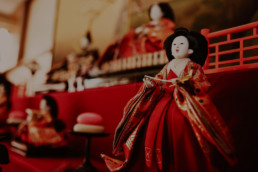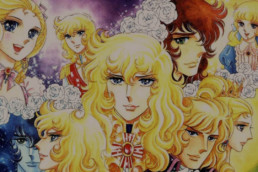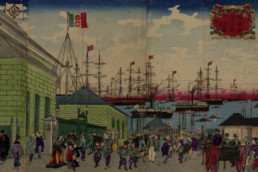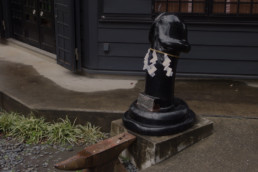Japan Folklore: Nippombashi Street Festa
photo credits: jnto.go.jp
In Osaka, anime and manga come to life
Every year since 2005, between early days and mid-March, the streets of Den Den Town located between Ebisucho Station and Nihonbashi are closed to car traffic for the biggest cosplay event in all of Japan: the Nippombashi Street Festa (日本橋ストリートフェスタ).
Den Den Town is the electronic district of Osaka that, thanks to its toy stores, video games stores and computer stores, has begun to attract a large number of manga and anime fans, soon turning into one of the "sacred" destinations for Otaku. Each year the festival is enhanced by attracting not only the local but also a more international audience!

photo credits: reddit.com
The Festival begins!
Preparations for the event start around 11:00 am with the roads closing to traffic. Here, above the street the main stage on which guests, cosplayers and sponsors alternate throughout the day is built.
The opening ceremony begins at 12.00 pm when a road is created for the parade of the 1,000 best cosplayers from around the world. After the show, cosplayers perform and pose for all those wishing to approach their favorite character. Many of them take advantage of the event to promote their socials accounts, writing their address on whiteboards or signs placed next to them while they are immortalized in the poses studied in advance.
Obviously the event is not open only to professionals, but hundreds and hundreds of people wear their own costume. It doesn’t matter if this belongs to pop culture, anime, manga, video games or even cartoons and characters from American comics (especially Marvel, Adventure Time and Star Wars), almost 10,000 people a year turn into their own hero! Of course, the festival is free, but if you want to participate in the parade, an entry fee of around 1,500 yen is needed.
The event is also the perfect opportunity to find unique designs by Nippombashi Street Festa and exclusive goods.

photo credits: nippombashi.jp
The cultural exchange project between Japan and France and an exceptional ambassador
From 2018, year of the 160th anniversary of friendship between France and Japan, the 「Japan-France pop culture Exchange project」was promoted in order to deepen the cultural exchange between manga, animation, music and other aspects of Japanese pop culture with the France in collaboration with the「Japan Expo」.
To disseminate the event and make it even more alive, KAMIJO, the talented Japanese artist who became particularly famous in France, was chosen as the project's ambassador.
This year the Nippombashi Street Festival will be held on March 9th and will be the perfect opportunity to immerse yourself not only in the magical world of fantasy, but also in the musical world!
Japan Tradition: Hinamatsuri

photo credits: mcasiwakuni.marines.mil
Doll’s Day
There is a special celebration held annually on the third day of the third month in Japan known as Hina-matsuri (雛 祭 り), also known as Doll’s Day or Girl’s Day. During this celebration, the misfortunes of girls are transferred to the dolls and the family members pray to the gods for their daughters’ good health and beauty.
This festival dates back to the Heian period (1650) and in Japanese culture, dolls have always been believed to have the capacity to contain evil spirits. During the Hina-Nagashi (雛 流 し, The floating doll) ceremonies, straw dolls will be placed along the course of a river to take the evil spirits away with them. This ritual is still carried out in some parts of Japan.

photo credit: monchhichi.net
The Dolls of Hina-dan (雛 壇)
The hina-dan is a platform of 7 steps covered by a red carpet with a rainbow stripe at the bottom, called hi-mōsen. The hina ningyo, ornamental dolls passed from generation to generation, are placed on this hina-dan.
On the first step, the highest step, are the dolls representing the imperial court of the Heian period, the position of emperor and the empress, behind them a small golden screen and two lanterns of paper or silk on the sides.
On the second step there are three court ladies serving sake and separated by two small round tables (takatsuki), on which seasonal sweets are displayed.
On the third step there are five male musicians who are arranged from right to left and based on the instrument they hold in this order: a musician seated with a small drum, a standing musician with a large drum, a standing musician with percussion, a sitting player with the flute and, finally, a singer seated with a fan in his hands.
On the fourth step there are two ministers: the younger is placed on the right, the elder on the left. Both of them are equipped with bows and arrows while separated by takatsuki.
Three samurai, protectors of the emperor and the empress, are placed on the fifth step. They each hold a rake, a shovel, and a broom with respective expressions of weeping, of laughter, and of rage.
On the sixth step there are the objects that the court uses inside the building.
On the seventh and final step, the lowest tier, are the objects the court uses when they are far from the building.

photo credit: trend-blog-site.com
Between kimoni, hishi-mochi and amazake
During the festival, girls wear their most beautiful kimonos or dress up like dolls. There are numerous themed parties where shirozake, a special sweet and non-alcoholic sake based on amazake (甘 酒, a sweetener obtained from the fermentation of rice), arare (あ ら れ, crackers composed by glutinous rice and flavored with soy sauce) and the traditional sweet of Hina-matsuri, hishi-mochi (菱 餅 ひ し も ち) are served.
Hishi-mochi is a cube-shaped glutinous rice mixture made up of three colored layers. Each layer holds special meanings. Green represents the grass and symbolizes health; white represents snow, a symbol of purity; and finally, rose represents the plum blossoms fighting malignancy. Together these three colors indicate the arrival of spring, when the snow melts, the grass grows and the plum blossoms start to bloom.
Japan Folklore: Versailles no bara, the best-selling manga

photo credit: nefariousreviews.com
In 1972, Riyoko Ikeda created what became the manga and, later, the most famous anime of all time: "Versailles no Bara" (ベルサイユのばら, The Roses of Versailles, known in Italy as Lady Oscar). The talented mangaka, whose meticulous and elegant style has come to stand out and be considered the Shōjo Teacher, had to face her own publisher before seeing her published idea. The publisher was in fact convinced that a biographical manga starring Marie Antoinette could bore readers. Riyoko Ikeda undertook to prove otherwise and in May 1972 the first instalment of "Versailles no Bara" appeared on Shukan Margaret issue number 21, published by Shūeisha, on a weekly basis for a total of 82 episodes ended in 1973.
Between 1972 and 1974, 15 million copies were sold, thus electing Riyoko Ikeda as the queen of the historical manga.
photo credit: supereva.it
The history of the roses of Versailles and the wind that swept over them
In the last years of the Ancien Régime, the young Marie Antoinette of Austria was promised to marry the French dolphin, Luigi Augusto, nephew of Louis XV but his cousin, the Duke of Orleans plotted to kill him and usurp the throne. At the head of the Royal Guard was Oscar François de Jarjayes, a young noblewoman raised by her father, General De Jarjayes, as if she were a boy because he wanted a male heir. Alongside Oscar was a young attendant, André Grandier, nephew of the housekeeper of the Jarjayes family, to whom the General had entrusted the task of serving and protecting her. Covering her role, Oscar foiled many plots that aimed to kill the two princes, thus leading to being esteemed and considered a friend by Marie Antoinette. The capricious future queen, escorted by Oscar at a ball court, met the Swedish count Hans Axel von Fersen, of whom both women fall in love.
At the death of the King, Marie Antoinette and Louis XVI became sovereigns of France and, since the slander on a presumed relationship between Fersen and the Queen did not take long to spread, the count abandoned the country to avoid scandal and enlisted in support of the revolutionaries of America. Marie Antoinette, more and more unhappy and lonely, allowed herself to be influenced by the Countess of Polignac, an ambitious woman who became her favourite and urged the queen to squander money in frivolity. After a few years, the Count of Fersen returned to France and inevitably went back to Marie Antoinette, who, unable to control her feelings, was on the verge of a scandal. Once again the count left the country and the queen, following the birth of the heirs to the throne, decided to move away from the life of the court and retire with her children in the Petit Trianon, arousing the hatred of the high nobility. In the meantime, the famous "Deal of the Necklace" broke out, which threw the first shadows on the public reputation of the queen. Shortly after, Fersen returned from America and during a court ball, Oscar showed up in disguise dressed for the first and only time as a woman but, dancing with Fersen, realized that she could never replace the queen in the heart of the Swedish count and she decided it was probably better to live forever like a man. Following the case of the Black Knight and the further attempt to discredit the royal family in the eyes of the nobility, Oscar abandoned the command of the Royal Guard obtaining from the queen the post of commander of the French Guards regiment of Paris. André, despite being rejected by Oscar after declaring her love, he remained by her side anyway.
General Jarjayes realized that he had made a mistake in allocating his daughter to a military career and began to wish that she would marry, so the second of Oscar in the Royal Guard, Girondel, made her a marriage proposal, but Oscar did not accept, preferring her new soldiers and attempts to earn their respect. The French revolution was at the door: Oscar, who understood to love Andrè, sided with him on the side of the people and together died during the riots of the storming of the Bastille July 14, 1789. The years of the revolution lasted until Marie Antoinette’s execution on the guillotine on October 16, 1793.
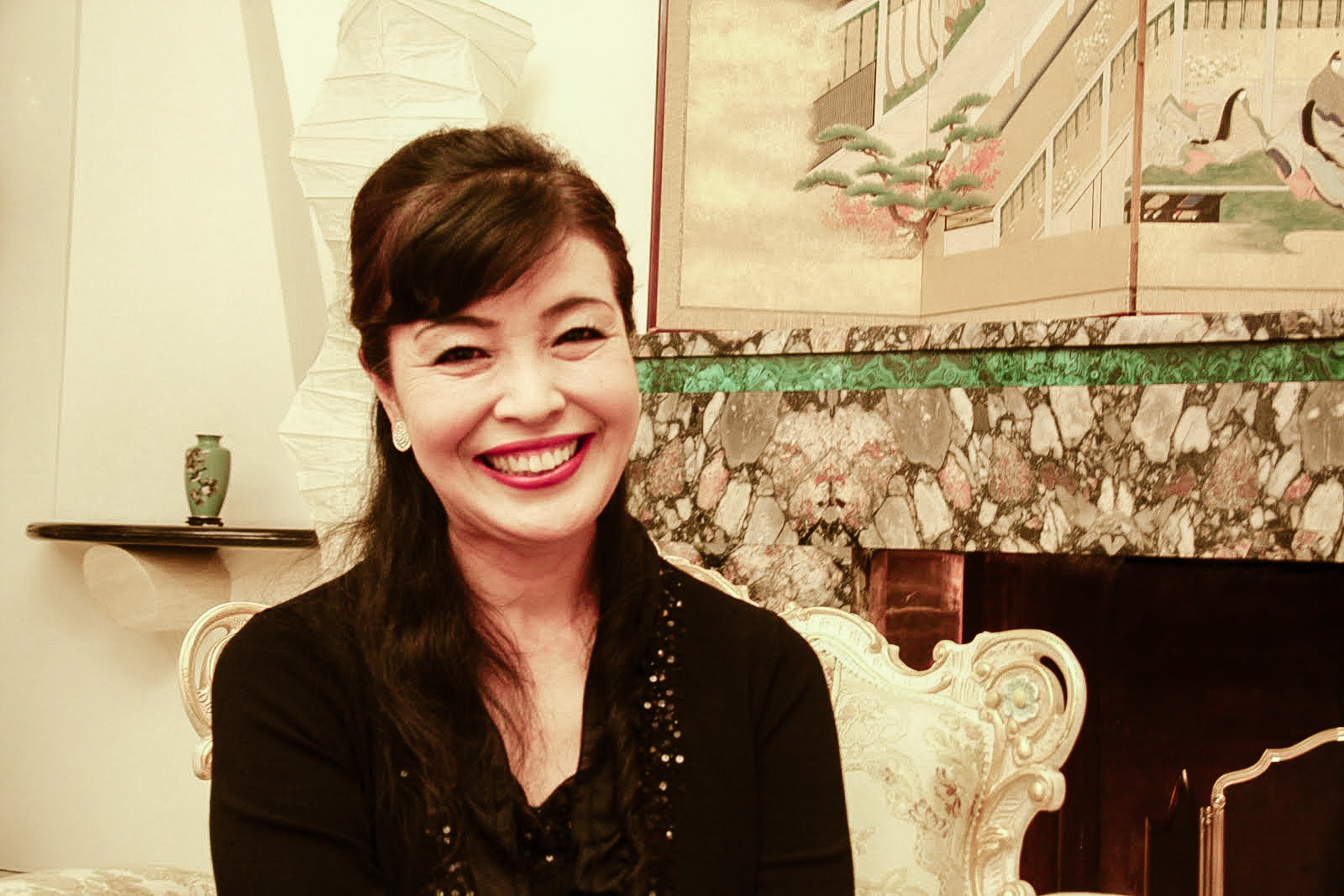
photo credit: romaspettacolo.net
One series is not enough!
Twelve years after the mother series, Riyoko Ikeda decided to publish a 4-episode miniseries entitled Versailles no bara gaiden (The Roses of Versailles - Gothic Stories) whose protagonists are Oscar, Andrè and the little Loulou de La Lorencie, Oscar's niece. The episodes narrated are placed between volumes 7 and 8 of the original manga. In 1987 Eikō no Napoleon-Eroika (栄光のナポレオン-エロイカ, The glorious Napoleon - Heroic) also appeared as the official sequel, whose title "Eroika" refers to the third symphony of Ludwig van Beethoven, dedicated to Napoleon. These 12 volumes narrate the events of Napoleon immediately after the French Revolution: his empire, the Italian campaign, the campaign of Egypt, the battle of the Nile, the coup d'etat of the 18th Brumaire and the French invasion of Russia. in the course of the narration, some of the already known characters will reappear, but only through flashbacks.
In 2006, Riyoko Ikeda decided to take the pencil again to create "Berubara Kids": an amusing reinterpretation in coloured stripes in which the characters of Versailles no Bara reappear in "chibi" version in key scenes. The small parody was published weekly on "Be", a supplement of the newspaper "Asahi Shimbun".

photo credit: pinterest.it
Roses die in beauty
The fascination of Versailles no Bara pushed many musicians to reinterpret the famous "Bara wa utsukushiku chiru" original song of the anime, but Riyoko Ikeda recognized the LAREINE version with license. The first CD came out on October 1, 1998 and in limited number of copies: only 500 with serial number of which the first 4 were owned by the members of the group. Fortunately, in 1998 it was re-edited and Bara wa utsukushiku chiru officially became the fourth single of the band. On February 9th 2000 the most valuable CD edition was released, containing only two audio tracks in which Riyoko Ikeda herself participated as a soprano singer and took care of the graphic design, also designing the costumes of the band for the music video.
Japan History: Italy & Japan 150 Years of Friendship
Italy & Japan 150 Years of Friendship

Photo Credits: Ambasciata del Giappone
150 years of friendship between Italy and Japan was celebrated in 2016.
This relationship between these two countries dates back to 1866, on the 4th of July, when an Italian military ship sent by King Vittorio Emanuele II arrived in Yokohama port to offering a treaty of friendship and commerce.
Back then, both countries had a common goal. They were eager to close the economic distance that separating them from the other more influential and powerful countries in those days.

Photo Credits: L'inviato Speciale
An alliance for better or for worse
After the end of First World War, Italy and Japan experienced same outcome. They both won the conflict, however both felt "betrayed" following the Versailles Treaty. Italy suffered from the indignation of not getting all the territories that it expected while Japan suffered from diplomatic defeats in the rejection of Japan's bid for a racial equality. Moreover, the two countries were experiencing critical post-conflict economic situations that would have led towards a totalitarian regime of the Second World War.
In 1937, Italy went against the Russian’s communist politics, like how Japan did when they signed the Anti-Komintern Pact with Hitler's Germany. In the following year, the fascist national party landed in Japan, and Mussolini's works were translated into Japanese. The Germany-Japan-Italy Tripartite Agreement was signed, creating the Rome-Berlin-Tokyo alliance. In that period Mussolini made several visits to Japan.
All those who refused to join the fascist party in Japan were interned in the camps at Nagoya.
The atomic bombs dropped to Nagasaki and Hiroshima hit Japan hard and both Italy and Japan had to recover from the tragedies caused by the war. At the end of the Second World War, both countries underwent radical transformations.

Photo Credits: Il turista curioso.it
An eternal bridge
The bridges built between the two countries continued to multiply over the years. In 1970, the first intercontinental television link between NHK and RAI broadcasters led to new cultural exchanges, allowing the products and lifestyles, from food to martial arts and increasingly intense linguistic exchanges, to grow ever closer.
In recent times, the mutual influence between the two nations also translated into architectural works.
Architect Kenzo Tange, who gave Tokyo its present-day landscape, designed numerous buildings in Italy, like the towers of the Bologna exhibition center and the business center of Naples, while Renzo Piano designed the Osaka airport and Ushibuka Bridge.
These days, Japan and Italy continue to enjoy cordial and friendly exchanges, growing and strengthening their relationship with each other as they always have through the past 150 years.

Metropolitan Governement Building Shinjuku Park Tower
Photo Credits: Japan italy Bridge

Ushibuka bridge, Photo Credits: Wikipedia.org
Japan Travel: Hanami
Hanami
About Hanami, or the Flower viewing.
In Japan, spring is synonymous with Hanami. Written with the kanji: Hana 花 "flower" and mi 見 "viewing", the word hanami means enjoying the beauty of blooming flowers. In particular, it refers to the Sakura: cherry blossom.
To understand the profound meaning of this magical tradition, Yosa Buson's haiku is perfect:
“Cherry petals
in the rice-seedling water,
moon and stars.”
In these words we read the aesthetic symbolism behind the relationship between nature and human beings in which everything becomes harmonious. Spring is, in fact, a "rebirth", therefore a renovation of the soul and of the spirit. The falling flowers indicate the transience of things. As flowers reach the peak when they bloom and then fall to be carried away by water, beauty is therefore wonderful and ephemeral at the same time. In Japanese, we can summarize this concept in the small sentence 物の哀れ, "mono no aware". This aesthetic concept expresses a strong emotional participation toward the beauty of nature and human life, with a consequent nostalgic feeling linked to its incessant change.
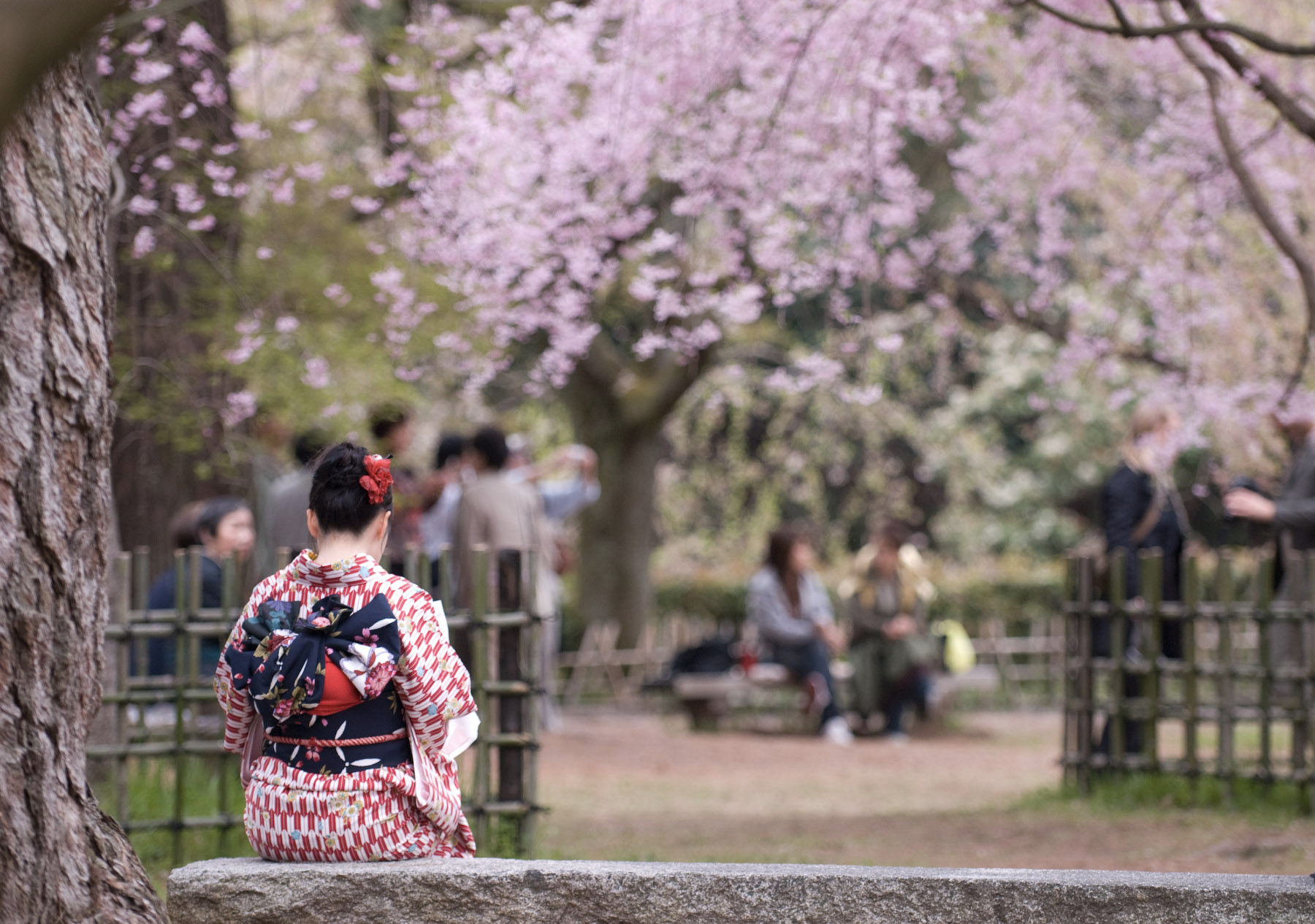
Photo Credits: regex.info
The Roots
Yoshino hills is where cherry trees originated in Japan. The legend says that in the VII century the priest En-no-Ozuno planted some sakura trees casting a curse on them. The curse would hit anyone who dared to cut the trees down. However, there are those who say that the hanami came from China, at the time of the Tang dynasty, which influenced Japan in the Nara period. Originally, there where the “ume” (prunus trees) to offer viewers the spectacle of their flowering. During the Heian period (794-1185) however, the Japanese imperial court moved to Kyoto where the unparalleled beauty of the cherry trees outshone that of the prunus.
Murasaki Shikibu, the court-lady that wrote the "Genji Monogatari”, the first novel ever written, used the word “hanami” related to the cherry blossom viewing for the first time. In the beginning, it was a rite restricted to an elite of nobles, dignitaries, samurai and poets, that drank sake and recited haiku on the beauty of the cherry blossom. In the following Edo period, the hanami spread to lower classes as well, eventually becoming a national holiday. This was also thanks to the shogun Tokugawa Yoshimune that planted areas of cherry blossom trees all over Japan.

Photo Credits: kabekin.com
Between Beauty and Transience, Hanami today
The hanami takes place in a period of time that extends from March to April when sakura reaches their blooming season. Traditionally, people gather together laying out their blue tarps under the trees and, armed with their bento, enjoy the spectacle of nature eating traditional dishes. Among them we can find the hanami-dango, rice dumpling of three colors: pink, white and green, accompanied by green tea and lots of sake. Another typical dish is the sakura mochi, a sweet made of red bean paste and rice, all wrapped in a pickled cherry blossom leaf. And the enjoyment goes on until the evening arrives, culminating in the Yozakura 夜桜 when the night is illuminated by chochin, traditional colored lantern made of paper.

Photo Credits: thespruce.com
Chasing after the best view
Japan is completely invaded by the simultaneous blooming of the trees awaken from the winter torpor, something that strikes the heart as well as the eye. But there are places where the charm of nature is more overwhelming than anywhere else. Among the must-see spots there is the Maruyama park in Kyoto, that is famous for the Shidarezakura, the unique weeping sakura. In Tokyo we can find the Ueno Park with its ancient temples and the Shinobazu pond. The Himeji castle, Hyōgo prefecture, is surrounded by a labyrinth-like wood of cherry trees, while the Hirosaki Castle, Aomori prefecture, is famous for its 2,600 cherry trees. Also, Mt. Yoshino, Nara prefecture, is where 100.000 cherry trees stand out on top of the mountain.
Japan Folklore: Kanamara Matsuri
Kanamara Matsuri

Photo credits: pictureasiastudio.wordpress.com
The festival of the "Steel Phallus"
The Kanamara Matsuri (かなまら祭り) is often welcomed by foreigners as yet another quirk from Japan, but in fact, the origins of this festival are very old and they are related to Shinto religion.
It all began in the Edo period, in 1603, when the town of Kawasaki was the destination for travelers who found their enjoyment in tea houses and, in private, entertained themselves with prostitutes. Prostitutes that used to visit the Kanayama temple to pray for protection from sexually transmitted diseases.
There is also a legend that revolves around the name of the Kanamara Matsuri, according to which a demon with sharp teeth lived in the vagina of a young girl. Any man who had intimate relations with her ended up irreparably castrated. Her husband too fell victim of the demon on the first wedding night and the girl, now desperate, asked for help to a blacksmith. The man forged an iron phallus that broke the demon's teeth and freed the woman from the curse. To celebrate, a small Shinto temple was erected becoming the place where the iron phallus is still venerated today.
The tradition was lost in late 1800s but, in the 1970s, chief priest Hirohiko Nakamura decided to revive the lost festival.
For centuries, the Kanayama temple has been the place where couples pray for a child, or where to pray for luck in business, an easy delivery or simply family harmony.

Photo credits: matome.naver.jp
3 Mikoshi and no preconcept
Every year, on the first Sunday of April, priests of the Kanayama Jinja in Kawasaki organize this festival.
The parade opens up with a shinto ceremony at the shrine where sake and fried fish are distributed to all visitors as a wish for good luck. Finally, the big pink penis placed on an altar is brought to the temple. At this point, the parade actually starts following three mikoshi, each containing a huge phallus. The first one stands erect and is made of a polished black metal. The second is an old wooden one, ancient and gnarled, and both are transported by carriers of the shrine who sing along the procession. The third one is entrusted to a joso group: they are members of a cross-dressing club called Elizabeth Kaikan. Its members, with their bright make-up and colored wigs, move the mikoshi in the air preening for the cameras.
After the parade, everyone gather to enjoy street-food, sexual-themed competitions and the cheerful atmosphere. Among the proposed challenges there is the sculpture contest, with sculpture that must have a phallic shape of course, or a rodeo with a big rotating penis. The festival is attended both by locals and tourists that, for the occasion, leave aside all taboos. The great majority of people wear all sorts of extravagant things, as fake penis-noses, while eating foods of the same shape.
We can also come across young women posing for photos while riding on swings that for the occasion have the shape of wooden penises.
This Festival, still loyal to its origins, celebrates sexual awareness and the prosperity of the whole community donating all the proceeds to HIV research.

Photo credits: flickr.com
Japan Folklore: Hōnen Matsuri
Hōnen Matsuri

Photo Credits: google.it
The Honen Matsuri is celebrated every year on March 15 throughout Japan. The most famous one takes place at the Tagata Jinja, in the small town of Komaki, outside Nagoya, with photos and videos available on the Internet. But in other parts of Japan, such as the Honen Matsuri of Okinawa, this festival is still considered a sacred and secret rite and no photo or recording is allowed. Even speaking or writing about what has been seen is technically prohibited.
Hōnen Matsuri (豊年祭), literally “Harvest Festival”, has a 1500-year-long history: its purpose is to guarantee the fertility of the harvest for the following year. A ritual full of blessings for the harvest, but also for all sorts of prosperity and fertility in general. This celebration could take on obscene features, at least in western eyes, because its symbol is a 280 kg cypress pine phallus, with a length of 2.5 meters. But it is absolutely not like that.
Phallic rites have in fact prehistoric origins. It is believed that this local indigenous rites, and the corresponding vaginal fertility practices and beliefs, were easily accommodated by the new system of Taoist beliefs that were taking root in Japan. System of beliefs that would later form the Way of Yin and Yang, the traditional esoteric cosmology. The local fertility cults co-existed and appear to have been encouraged, institutionalized and presided over by the royal elites from Nara. Élites who established themselves as feudal lords over expanded local areas.
The celebration of fertility
An important element of Japanese Shinto festivals are processions, in which the kami (Shinto divinity) of the local shrine is transported across the city in a mikoshi 神輿 or 御輿 (palanquin, small portable shrine). It is the only time of the year in which the kami leaves its shrine to be carried around the city. It is said that this transporting of the deity rite is based on a legend about the enshrined kami, Takeinazumi-no-mikoto. He had an enormous penis and took a local woman, Aratahime-no-mikoto, as his wife.
At 9:00 am preparations are underway: food stands peep out with their chocolate bananas carved in the shape of a penis and decorated at the base with marshmallows. Here and there, stalls of souvenirs, statuettes and other objects to be offered to the loved ones wishing for great fertility. These statues allow couples to pray for a child, the unmarried pray for a husband or wife, while farmers hope for abundant harvest. Everything enlivened by the unfailing distribution of all-you-can-drink sake contained in big wooden barrels.

Photo credits: thingstodoinnagoyawhenyouredeaddrunk.wordpress.com
The ceremony begins around 10:00 pm. Priests sprinkle the road with salt to purify the way ahead of the carriers. They also say prayers and impart blessings on participants and mikoshi, as well as on the large wooden phallus that has to be carried along the parade route. The starting point is a shrine called Shinmei Sha (on even-numbered years), located on a large hill, or the Kumano-sha shrine (on odd-numbered years), to arrive at the Tagata Jinja shrine. Once here, there is the traditional mochi nage rite: participants fight to grab one of the small rice cakes thrown by the officials from their raised platforms. These sweets will bring good luck for the next year.
Japan Travel: Fushimi Inari
Fushimi Inari

Photo Credits: japanitalybridge.com
Thousands of vermilion gates
A trail made of many vermillion torii, one after the other: this is the most recognizable symbol of the Shinto shrine Fushimi Inari Taisha (伏見稲荷大社). The complex is located in Fushimi ward, south of Kyoto, and it is the most important of several thousands of shrines dedicated to the kami Inari. Inari is the Shinto deity protector of the prosperity and wealth of crops, especially rice.
Reaching this holy place is very simple as it is located opposite the JR Inari station. Alternatively, you can walk a short distance from Fushimi Inari Station served by Keihan Main Line
This is a temple of ancient origins and its foundation dates back to before 794, when Kyoto became capital. Initially built on the Inariyama hill, southwest of Kyoto, it was re-located in 816 on the request of the monk Kourai. The current main structure of the temple was built in 1499.

Photo Credits: japanitalybridge.com
At the entrance there is the Romon Gate which was donated in 1589 by the famous leader Toyotomi Hideyoshi (he was a famous samurai and daimyō of the Sengoku period, founder of the Toyotomi Clan. Succeeding his master Oda Nobunaga in the work of reunification of Japan, he is considered as the second of the three "great unifiers".)
Beyond the Romon Gate stands the main hall of the shrine (honden) where visitors should make a small offer as a sign of respect for the deities enshrined here.
At the back of the main land of the shrine there is the entrance to the hiking trail made of torii ( 鳥居 traditional Japanese gateway to a jinja, shinto shrine). The trail begins with two dense rows of parallel gates called Senbon Torii ("thousands of torii gates”). The torii straddle a network of trails leading into the flourishing forest of the sacred Mount Inari (Inari-yama), which stands at 233 meters above sea level. Each gate was donated by individual worshippers or companies and has an inscription indicating the name of the donor and the date of the donation itself.

Photo Credits: masterfile.com
The Fox
Along the trails there are the statues of sitting foxes (Kitsune 狐), especially placed in north-east locations, that have the role of guardians whose duty is to prevent the demoniac energy from entering the earthly world. Foxes are also considered Inari's messengers. According to tradition, Inari used to live in the mountains during the winter, coming down in spring during the growing season. After the harvest, Inari would once again return to his winter residence. Every season foxes approached humans’ houses in the same way and, over time, they were recognized as natural messengers of the god.

Photo Credits: japanitalybridge.com
They are a recurring subject and an element of particular importance for the Japanese culture. In fact, they represent sacred and mysterious creatures endowed with a great intelligence and strange supernatural powers that they develop with age. Their main skill is to change shape taking human form (as they often appear in the form of a beautiful woman). Another power they are said to have is that of the Kitsunetsuki (狐憑き o 狐付き) or else, the ability to possess human beings. It was believed that a fox was able to enter the body of its victims, usually young women, through a nail or their chest, thus feeding on their vital energy living inside their bodies.
Inari’s kitsune are white, a color considered to be auspicious. They possess the power to ward off evil, and sometimes act as guardian spirits. In addition to protecting the shrines of Inari, they protect the locals by acting as a scarecrow against the evil nogitsune, fox spirits who are not in the service of Inari. Black foxes and nine-tailed foxes are also believed to bring good luck.
Some of the foxes along the trails hold a key in their jaws that represents the key to the rice granary.
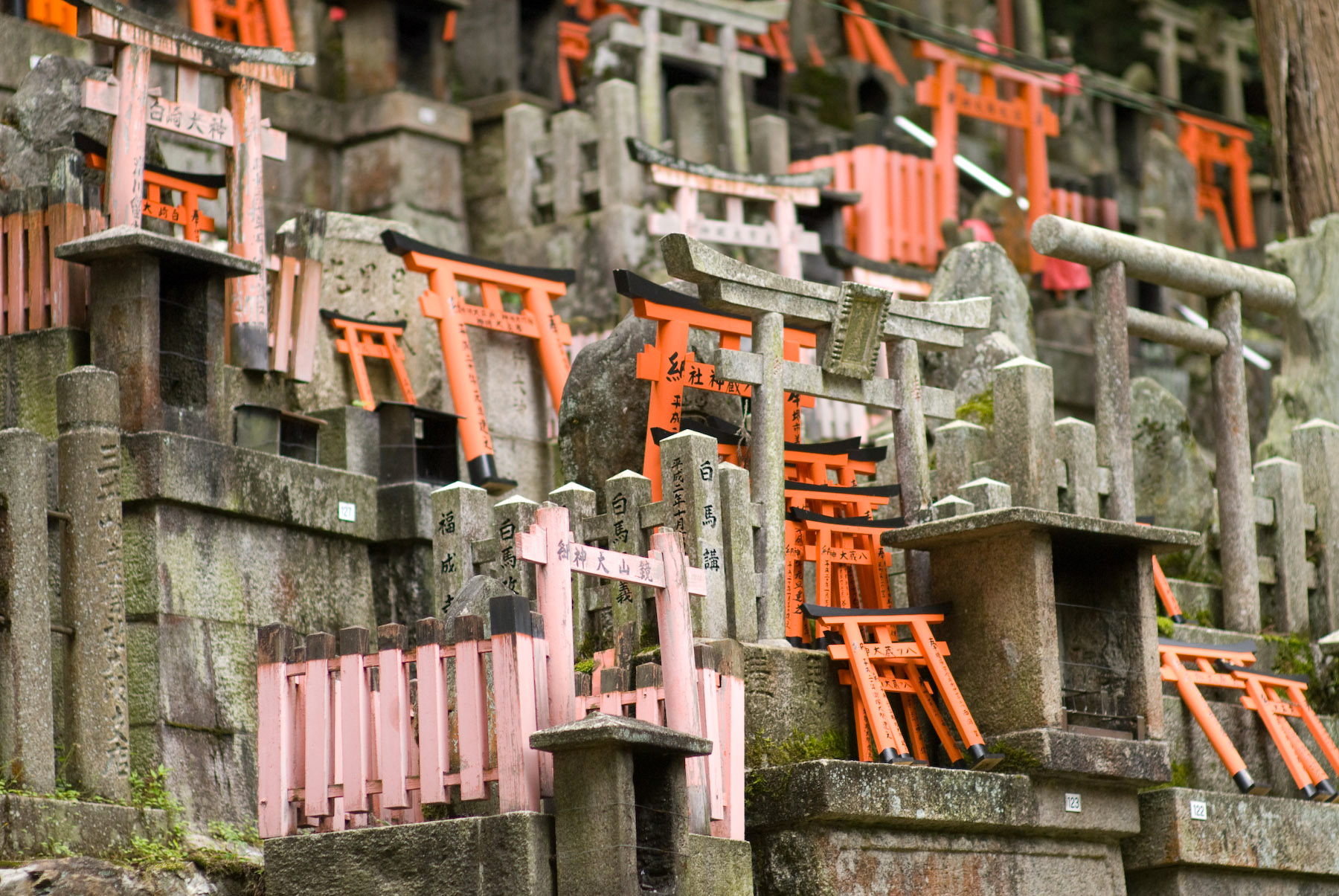
Photo Credits: regex.info
Up to the Inari-yama
Reaching the top of the mountain takes about 2 or 3 hours, and along the way there are many smaller shrines with piles of miniature torii donated by visitors on lower budgets. There are also some restaurants that offer local themed dishes such as Inari Sushi and Kitsune Udon ("Fox Udon"), both with pieces of aburaage (fried tofu), which is said to be the favorite food of foxes.
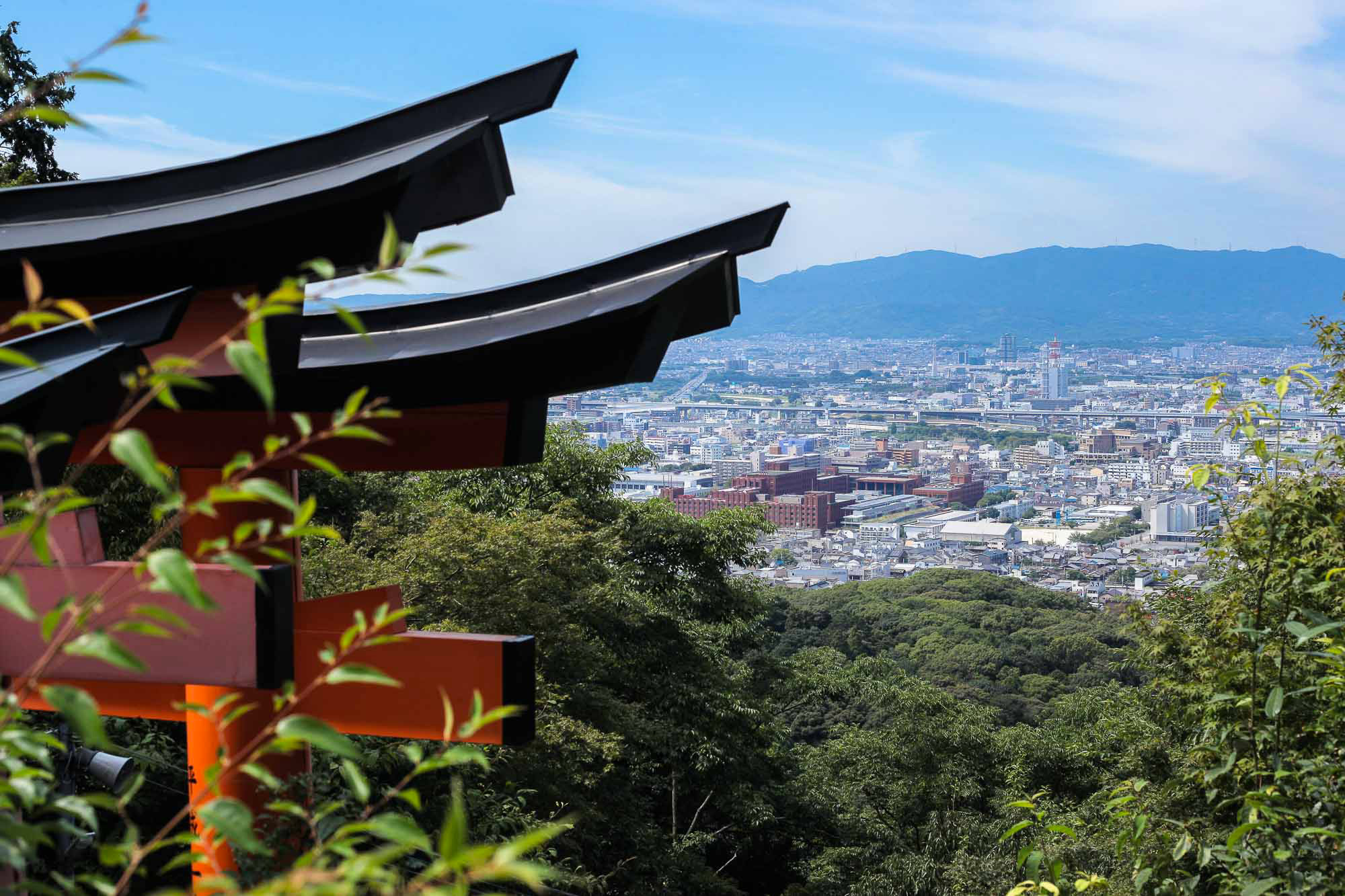
Photo Credits: crafttabby.com
After the first half hour of walking, the torii gates begin to gradually decrease until they reach the Yotsutsuji crossing, about halfway up the mountain. From here you can enjoy a splendid view of Kyoto.
At this point the trails divides into a circular path to the top.









